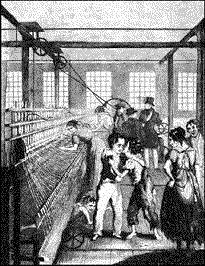The most important factor leading to the growth of consumerism during the period was of course, the Industrial Revolution. Factory production meant that goods could be produced faster and in
 quantity and sold at lower prices. In some areas, such as furniture making, powered production added to intricacy and quality that allowed the adding of "decorating" features such as curves and bulbs which could not be achieved by hand. And with the growth of the railroad, goods were now able to be distributed much more easily and less costly to rural areas than ever before.1
quantity and sold at lower prices. In some areas, such as furniture making, powered production added to intricacy and quality that allowed the adding of "decorating" features such as curves and bulbs which could not be achieved by hand. And with the growth of the railroad, goods were now able to be distributed much more easily and less costly to rural areas than ever before.1
"Looking" became a part of the shopping process. More and more of the middle and upper class women had time to spend looking for clothing, furnishings and more. Store fronts became more elaborate with the addition of expensive glass windows drawing the shoppers into their stores to view more of their wares, thus "looking" became synonymous with "window shopping".
Additionally, the growth of the British Empire contributed to the consumer revolution as it had increased access to goods from all over the world. This can be seen in Charles Dickens's Dombey and Son in 1848: "Just round the corner stood the rich East Indian House, teeming with suggestions of precious stuffs and stones, tigers, elephants, howdahs, hookahs, umbrellas, palm trees, palanquins . . .1
Despite the growth and prosperity of the middle class during the period, approximately 1/2 to 2/3s of the population remained extremely poor and were unable to take advantage of the advances taking place. The frequency of shopping depended on one's wealth and there were shops that catered to the rich, the middle class and the poor.
The class system in Britain was quite complex and there were several levels of middle class and working class. Only 5% of the population was considered elite or noble. Examples of "middle class" was a doctor or lawyer, a large farm owner or a schoolmaster who ran his own school and "working class" consisted of skilled tradesmen. Your wealth dictated the purchases you made, the frequency of those purchases and access to particular shops, goods and services. The class you were in also affected the way you looked at shopping in general.
Back to Intro/Index or Site Map
| | Family Gallery | Servants Parlour | Tour Home | Typical Day | Etiquette | Shopping Trip | |
| | Victorian Christmas | Victorian England Fun and Games | Ashton Library | Victorian Wedding | |
| | Victorian England Overview | Guest Registry | Honorary Victorian | Tours | |
| | Awards Received | Bibliography | |
| | 1876 Victorian England Home | |
Credits below copyright information |
| Contact
webmaster |
| Copyright
1999-2017 All Rights Reserved - B. Malheiro May not be reproduced in any way without express written permission of webmaster. |
Credits:
Background and buttons are the creation of webmaster, B. Malheiro. These images have been watermarked and are not for use on another site. Site authored by webmaster.